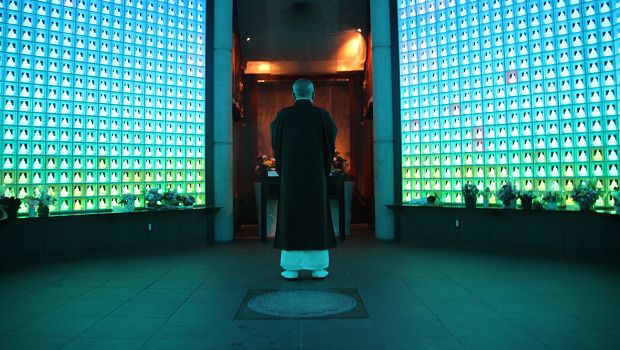Japan’s high-tech futuristic cemeteries
JAPAN – Yumiko Nakajima, a woman in her 70s, is selecting her grave. But instead of choosing a hunk of stone in a regular, outdoor cemetery, she has her sights set on a glowing blue glass Buddha statue inside Ruriden—a small, futuristic charnel house belonging to Koukoko-ji temple in downtown Tokyo.
Nakajima’s chosen Buddha statue is flanked on all sides by a collection of 2,045 LED-lit statues of variant hues, spread across the walls of this alternative graveyard space. Each statue—which is placed on the wall inside a transparent glass casing—either already represents a deceased person or will do so in the future, once a visitor like Nakajima decides to have his or her cremated remains housed in a storage locker located directly behind the wall. Synced up to swipe cards, the statues glow a different color when a visitor arrives so they can be located more easily.
“It’s fate that I got introduced to this style of graveyard. It’s much more convenient,” said Nakajima, as the technicolor Buddha statues reflected off of her glasses, and her shopping bags rustled beside her. “I don’t want my relatives to go to the trouble of maintaining my tombstone when I’m gone.”
In Japan, declining birth rates, shortages of space in cities, and skyrocketing prices for cemetery plots have brought on a radical rethink in how the deceased are both buried and commemorated by those they leave behind.
Traditionally, each family would own a plot of land and a stone tomb—togethercosting between 230,000 yen ($20,000) and 460,000 yen ($40,000)—in a physical cemetery in an urban area. As people die, their cremated remains are stored in burial urns and placed inside the family grave. The grave is passed down the generations and the upkeep of these tombstones and yearly maintenance fee are shouldered by living relatives, who will try and pay their respects as often as they can, or more likely during special occasions such as Obon—a three-day Japanese Buddhist festival during the summer that honors ancestral spirits.
Yet over the last few decades, advances in tech, as well as the changing lifestyles of the Japanese, have made high-tech graveyards a cost effective alternative. Cemeteries like Ruriden—which pack symbolic representations of the dead in orderly columns and house their actual remains in locker spaces—have gained ground in Japan.
Such cemeteries often use smart cards to allow people to store their information and that of their deceased relatives so that they can swipe to enter the building, and swipe once again to light up and distinguish their specific Buddha statue from the rest.
Read the rest of the article at the Motherboard website.


Leave a Comment
You must be logged in to post a comment.